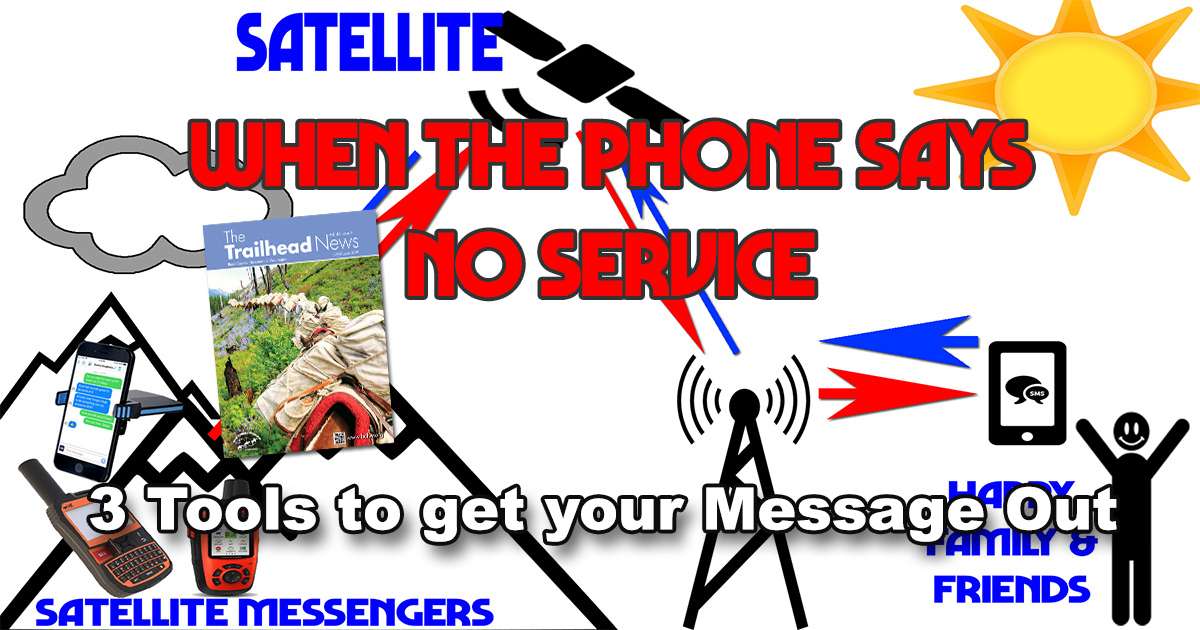When the Phone Says “No Service”
As published by the Trailhead News
When you’re out in the wild and need to call for help, don’t be surprised if your cellphone reads “No Service.”
Losing your cell signal while outdoors can be annoying — but if you’re out riding or camping your cellphone signal can mean the difference between life and death. Injuries, being lost, and any other number of hazards can mean we need to call for help — but if there’s no signal to carry your message, then what do you do?
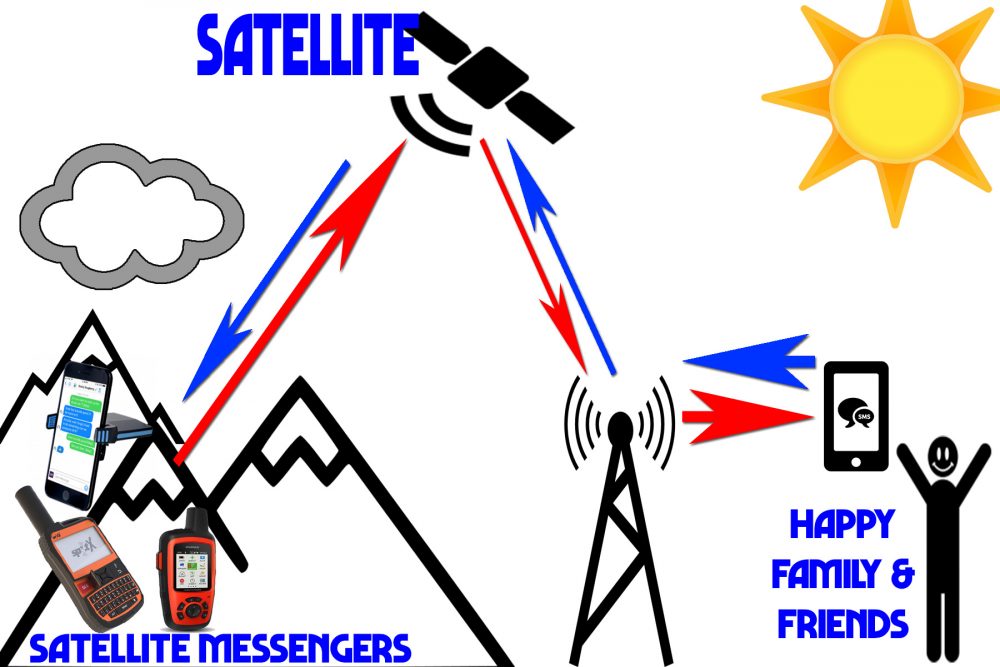
Unlike the phone you use every day, GPS communicators don’t need a cell signal to work. Instead, they use the network of satellites constantly orbiting overhead. Not only can they be used to track your position, but they can also be used to send and receive packages of data. We’re talking around 140 characters, like in the early days of text messaging. That may not sound like much, but it’s enough to tell your loved ones where you are (or that you’re delayed), receive medical advice, and even download an up-to-date weather report. They can also contact search and rescue virtually anywhere if the world if the sh@t really hits the fan.
I tested the three most promising satellite messengers from SatPaq, SPOT, and Garmin. I won’t sugarcoat it: none of these tools are perfect. That being said all of them could save your life when the trail gets rocky.

Each of these devices have a number of basic functions in common. When activated, all of them let you do the following in areas without cellphone reception:
- In case of a non-life-threatening emergency, alert your personal contacts that you need help
- In case of a life-threatening emergency, activate an SOS button that directly notifies emergency responders of your distress signal, as well as your GPS coordinates
- Send text-based messages to your personal contacts
- Create shareable online maps of your adventure so others can follow along in (near) real time
- Track your journey
SatPaq
A clip on antenna that turns your smartphone into a satellite communicator
- PRO: Inexpensive to purchase and to use. Takes advantage to the phone that’s already in your pocket.
- CON: Needs your cell phone
- PRICE: $250
- COST OF OWNERSHIP: .29 to .40 per message
NIFTY FACT: The SatPaq communicates through Geostationary (GEO) satellites when there is no cell or WiFi coverage. GEO satellites don’t move relative to your position on earth so they’re always in view and your communications can happen right away.
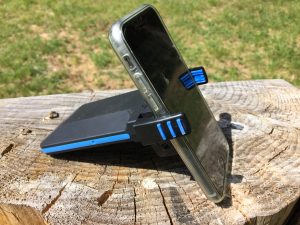 Horse and mule riders like to get off the beaten path – We long for the backwoods, and back country refuges of isolation where (hopefully) you won’t see people for days. The problem is when you’re this far in the backcountry, you’re also well out of cell coverage which can make a bad situation much worse if there’s ever a serious injury or illness. You won’t have to worry about that potential worst-case scenario if you’re carrying a SatPaq.
Horse and mule riders like to get off the beaten path – We long for the backwoods, and back country refuges of isolation where (hopefully) you won’t see people for days. The problem is when you’re this far in the backcountry, you’re also well out of cell coverage which can make a bad situation much worse if there’s ever a serious injury or illness. You won’t have to worry about that potential worst-case scenario if you’re carrying a SatPaq.
The SatPaq from Higher Ground is a lightweight device that easily clips to your smartphone and connects wirelessly using Bluetooth to communicate through satellites when there is no cell coverage. SatPaq’s SpaceLinq free app allows you to send and receive messages, get instant weather forecasts, share your location, and get help in emergencies – all without having to pay monthly service fees.
SatPaq also features an Artificial Intelligence medical service to answer first aid questions and an SOS service for emergencies. It’s iPhone and Android compatible and can hold a charge for 4-5 months in storage. SatPaq is also only 4 ounces — that’s less than my iPhone!
SatPaq eliminates the monthly fees associated with other satellite messengers through the purchase of message credits called MessagePaqs that allow you to use the service whenever you need. These message credits holdover until you use them.
If you spend time exploring away from cell phone coverage, the SatPaq is a very attractive piece of gear!
For more info – https://satpaq.com
SPOT X
A rugged communications device that will send texts independently, without a linked smartphone.
- PRO: QWERTY keyboard and a built-in digital compass
- CON: Keyboard has tiny hard to use buttons. Cannot pair with a phone. Does not support maps
- PRICE: $250
- COST OF OWNERSHIP: $164 – $380 per year
NIFTY FACT: The SPOT X is the company’s first device with two-way satellite messaging.
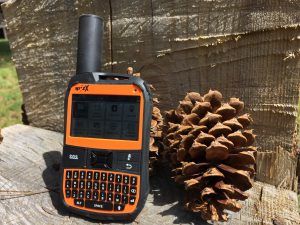 The SPOT X is a stand-alone two-way satellite messaging device. The other devices we tested allow for two-way, customized messaging, but they require a smartphone for easy typing. The SPOT’s built-in QWERTY keyboard makes it stand out. You compromise nothing by using the X on its own. In fact, you couldn’t link it with your smartphone even if you wanted to.
The SPOT X is a stand-alone two-way satellite messaging device. The other devices we tested allow for two-way, customized messaging, but they require a smartphone for easy typing. The SPOT’s built-in QWERTY keyboard makes it stand out. You compromise nothing by using the X on its own. In fact, you couldn’t link it with your smartphone even if you wanted to.
The Spot X can send and receive text messages and short emails. This makes it fundamentally different than SPOTS’s other devices such as the Gen3, which can only send messages. Messages can be predefined, custom, or even posted to social media to keep all of your peeps in the know. Each Spot X unit is assigned a personal U.S. mobile number, which makes sending messages to the device easy. The process of sending messages to the other devices we tested is less straightforward.
The Battery life of the SPOT X far surpasses that of the Garmin InReach; going twice as long (10 days) before a recharge is required.
Along with sending and receiving messages the SPOT X can also track your location at regular intervals; send SOS messages directly to the GEOS International Emergency Response Coordination Center; and function as a rudimentary navigation device with a built in compass and the ability to set waypoints.
The SPOT X is a solid backcountry communications option, so long as you can accept the keyboard and lack of mapping capabilities.
For more info – https://www.findmespot.com/spotx/lander.php
Garmin inReach
SMS devices allow users to communicate via text message to friends, family and rescue operators at a fraction of the price of regular satellite phones. These tools also allow for continuous tracking so that contacts back home can follow along with your journey.
- PRO: Reliable, Rugged, Accurate, Preloaded topographic maps
- CON: Unit is bulky, heavy, expensive
- PRICE:$300 – $450
- COST OF OWNERSHIP:$180 to $1,200 per year
NIFTY FACT: There are two flavors of Garmin inReach the Explorer+ and the SE+. The Explorer adds topo maps, a built-in digital compass, barometric altimeter, and accelerometer.
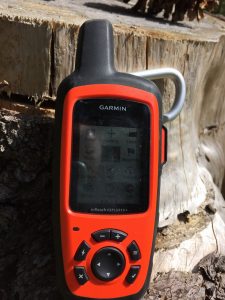 The Garmin inReach Explorer+ is a significant investment: it’s $450 for the device; service plans and insurance coverage add more to the cost. But what’s the price of safety and peace of mind? If I got into trouble, the inReach can help me get out. And for friends and loved ones, the ability to communicate with me while I’m in the back country is invaluable.
The Garmin inReach Explorer+ is a significant investment: it’s $450 for the device; service plans and insurance coverage add more to the cost. But what’s the price of safety and peace of mind? If I got into trouble, the inReach can help me get out. And for friends and loved ones, the ability to communicate with me while I’m in the back country is invaluable.
Rugged and ready, InReach devices use the iridium satellite network of 66 low orbit satellites offering 100% coverage worldwide to help ensure your messages are received.
Both versions of the inReach excel at messaging, as long as you set your expectations appropriately. Satellite communications, no matter the network or the technology employed, have inherent limitations. Sometimes you’ll have to wait a few minutes for satellites to pass overhead and send and receive the messages.
The simplest way to send messages with the inReach is through the Garmin EarthMate smartphone app. On the app, it’s easy to add your contacts and then send and receive a big batch of messages. Pre-programmed messages make it much easier to send quick updates, so you don’t have to type the same message multiple times. Without the phone app composing messages is a painfully slow process of ticking off characters on the inReach keypad.
For more info – – https://explore.garmin.com/en-US/inreach/
The Bottom Line: Which Satellite Messenger Should I Pick?
Your answer will depend on your unique needs. Here are the main questions that I consider before choosing a device.
- What are your biggest priorities? Easy, quick messaging? Battery life? Cost savings? Compact size and weight? Navigational tools?
- Do you plan to also carry a smartphone and use it in conjunction with your satellite messenger, or do you want a standalone device?
Beyond the classic 10 essentials, modern SOS devices provide a greater increase in your overall outdoor safety than most other gear available. They offer peace of mind to your loved ones, and two-way communication with search and rescue teams and medical professionals. Simply put, you should buy one, learn to use it and show your riding partners how to use as well, and bring it with you on every wilderness adventure.
Try each of the devices during TrailMeister trail riding and horse camping clinics. Clinic attendees have the opportunity to use and test live satellite messenger devices during my clinics. Check the schedule here – https://www.trailmeister.com/speaking/.


